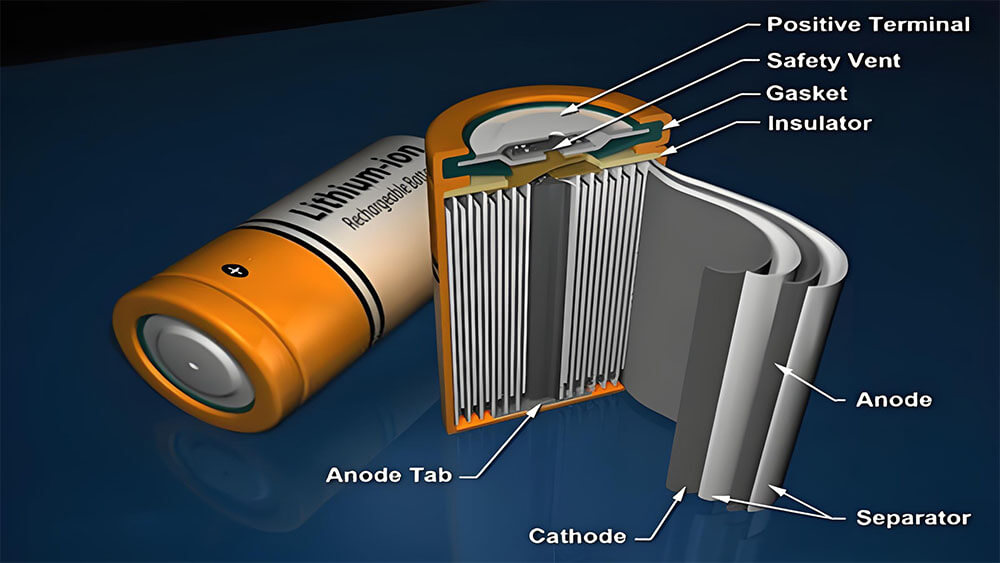Contents

The multi-tab battery cell has revolutionized lithium-ion battery technology by enhancing energy efficiency and performance. Its innovative design addresses the increasing demand for reliable power solutions across diverse industries. You can find these advancements in critical applications like medical equipment, renewable energy systems, and high-performance electronics. This breakthrough ensures optimized energy storage, improved durability, and better adaptability to modern energy needs.
Key Takeaways
Multi-tab batteries improve energy use and work better, making them great for modern tools like medical devices and green energy systems.
Their smart design lowers resistance inside and spreads current evenly, which helps batteries last longer and stay cooler.
Using multi-tab batteries can greatly increase power and dependability, helping the move to cleaner energy options.

Part 1: Design Principles of Multi-Tab Battery Cells
1.1 Defines of a Multi-Tab Battery Cell
A multi-tab battery cell represents a significant advancement in lithium-ion battery technology. Unlike traditional designs, this innovative approach incorporates multiple tabs within the cell structure to enhance performance and efficiency. These tabs serve as pathways for electrical current, ensuring uniform distribution across the cell. This design minimizes resistance and optimizes energy transfer, making it ideal for applications requiring high power density and reliability.
Key parameters define a multi-tab battery cell in industry standards:
The geometric area and format of lithium-ion cells play a crucial role in performance evaluation.
Metrics such as capacity, applied potential, resistance, and cycling stability are essential for assessing efficiency.
Large-area wound cells, such as 21700 cylindrical cells, are preferred for their superior electrochemical reliability.
Scaling up production processes presents challenges that can impact overall battery performance.
By addressing these criteria, multi-tab battery cells deliver consistent and reliable energy output, meeting the demands of modern energy systems.
1.2 Differences Between Multi-Tab and Traditional Battery Designs
Multi-tab battery cells differ significantly from traditional designs in terms of performance and efficiency. The following table compares key metrics:
Metric | Traditional Design | Multi-Tab Design | Difference |
|---|---|---|---|
Ohmic Losses (Copper) | 16 mV | 0.5 mV | 15.5 mV lower |
Ohmic Losses (Aluminum) | 17 mV | 0.8 mV | 16.2 mV lower |
Voltage Drop Throughout Recharge | Varies | 24-25 mV lower | 24-25 mV lower |
Current Density Variation | 22% higher at tabs | 1.3% difference | 20.7% more uniform |
These improvements result in better energy efficiency and reduced heat generation. The multi-tab design ensures a more uniform current distribution, which minimizes stress on individual components. This uniformity enhances the battery’s durability and reliability, making it suitable for demanding applications like medical equipment and renewable energy systems.
By adopting multi-tab battery cells, you can achieve superior performance and efficiency compared to traditional designs. This innovation represents a significant step forward in battery technology, addressing the challenges of modern energy solutions.

Part 2: Performance Benefits of Multi-Tab Battery Cells
2.1 Enhanced Current Distribution and Reduced Internal Resistance
Multi-tab battery cells excel in distributing current more evenly across the cell structure. Unlike traditional designs, which rely on a single tab, the multi-tab configuration minimizes the distance electrons travel within the cell. This reduction in electrical path length, from approximately 3.5 meters to just 75 millimeters in advanced 4680 cells, significantly lowers internal resistance. As a result, energy losses during charge and discharge cycles decrease, improving overall battery performance.
The uniform current distribution also reduces localized heating, a common issue in lithium-ion batteries. By mitigating hot spots, the multi-tab design enhances safety and prolongs the battery’s lifespan. This feature is particularly valuable in applications requiring consistent performance, such as industrial systems and renewable energy storage.
Tip: If you’re looking to optimize your energy solutions with advanced battery technology, consider exploring Large Power custom battery solutions tailored to your needs.
2.2 Improved Energy Efficiency and Power Density
The innovative design of multi-tab battery cells directly contributes to improved energy efficiency and higher power density. By incorporating multiple tabs, these cells reduce energy losses associated with resistance and heat generation. This efficiency translates into a 10% improvement in power density, even in existing 18650 designs. For larger formats like 4680 cells, the benefits are even more pronounced.
Key factors driving these improvements include:
Thinner Current Collectors: The multi-tab design allows for thinner current collectors, increasing the volume fraction of active materials within the cell. This change boosts the overall energy density of the battery.
Reduced Heating: Lower resistance minimizes heat generation, enabling the battery to operate more efficiently under high loads.
Enhanced Scalability: The design supports larger cell formats without compromising performance, making it ideal for industrial and renewable energy applications.
These advancements make multi-tab battery cells a preferred choice for high-performance systems, where energy efficiency and power density are critical.
2.3 Thermal Management and Longevity in Lithium-Ion Batteries
Thermal management is a crucial aspect of lithium-ion batteries, and multi-tab designs address this challenge effectively. By distributing current evenly, these cells reduce the risk of localized overheating. This uniformity not only enhances safety but also extends the battery’s operational life.
Empirical data highlights the impact of multi-tab designs on thermal performance:
Performance Aspect | Observation | Impact |
|---|---|---|
Absolute Error Reduction | Significant reductions in absolute error | Enhances model performance |
Dynamic Periods | Optimization improves performance during load | More robust models |
Rest Periods | Hysteresis inclusion reduces fluctuations | Consistent performance across cells |
The improved thermal management also supports higher charge and discharge rates, making multi-tab battery cells suitable for demanding applications like robotics and consumer electronics. By reducing thermal stress, these cells maintain their capacity and efficiency over more cycles, ensuring long-term reliability.
For businesses seeking sustainable and efficient energy solutions, multi-tab battery cells offer a compelling option. Their ability to combine high performance with durability makes them a cornerstone of modern energy systems. To explore how these innovations can benefit your operations, consider consulting with experts at Large Power.

Part 3: Applications in Modern Energy Systems
3.1 Integration in Medical Equipments
Multi-tab battery cells have become indispensable in medical equipment, where reliability and efficiency are paramount. Devices like portable ventilators, infusion pumps, and diagnostic tools demand consistent power delivery. The uniform current distribution of these batteries ensures stable operation, reducing the risk of sudden power failures. Their enhanced thermal management also minimizes overheating, a critical factor in maintaining patient safety.
Moreover, the compact design of multi-tab battery cells allows for lightweight and portable medical devices. This feature is particularly beneficial in emergency scenarios or remote healthcare settings. By extending the lifespan of medical equipment, these batteries contribute to cost efficiency and sustainability. For more insights into medical battery applications, visit Large Power’s medical battery solutions.
3.2 Role in Renewable Energy Storage Solutions
Renewable energy systems, such as solar and wind power, rely heavily on efficient energy storage. Multi-tab battery cells address this need by offering high energy density and improved charge-discharge efficiency. Their ability to handle larger cell formats without compromising performance makes them ideal for grid-scale storage solutions.
These batteries also excel in managing the intermittent nature of renewable energy sources. By reducing internal resistance and heat generation, they ensure consistent energy output, even during peak demand periods. This reliability supports the transition to sustainable energy infrastructure. To explore how these batteries align with sustainability goals, check out Large Power’s sustainability initiatives.
3.3 Use in High-Performance Electronics and IoT Devices
High-performance electronics and IoT devices demand batteries that can deliver power efficiently while maintaining longevity. Multi-tab battery cells meet these requirements through their innovative design. The following table highlights key performance metrics that validate their use in these applications:
Performance Metric | Description |
|---|---|
Internal Resistance | Affects efficiency and heat generation during operation. |
Open Circuit Voltage (OCV) | Indicates the maximum potential voltage of the battery when not under load. |
Cycling Protocols | Defines charging and discharging cycles to assess battery longevity and performance. |
Power Consumption Profiles | Essential for understanding how battery performance varies with different operational tasks. |
Aging Process | Evaluates how battery performance degrades over time under typical usage conditions. |
Voltage Range | Ensures safe operation within limits for all components. |
Lifetime Requirements | Determines the expected lifespan of the battery based on its application in various devices. |
These metrics demonstrate the adaptability of multi-tab battery cells in powering devices like smart home systems, wearable technology, and industrial IoT sensors. Their ability to operate efficiently under varying conditions ensures optimal performance and durability. For tailored battery solutions, consult Large Power’s custom battery services.
Multi-tab battery cells redefine energy storage with their innovative design and superior performance. You benefit from enhanced energy efficiency, improved thermal management, and extended battery life. These advancements transform lithium-ion technology, enabling breakthroughs in renewable energy, medical devices, and IoT systems.
Looking ahead: Multi-tab designs hold immense potential for further innovation, paving the way for smarter, more sustainable energy solutions.
FAQ
1. What makes multi-tab battery cells superior to traditional designs?
Multi-tab battery cells reduce internal resistance and improve current distribution. This innovation enhances energy efficiency, thermal management, and durability, making them ideal for modern energy systems.
Tip: Explore custom battery solutions tailored to your needs with Large Power.
2. Can multi-tab battery cells be used in renewable energy storage?
Yes, multi-tab battery cells excel in renewable energy storage. Their high energy density and scalability ensure consistent performance, even during peak demand periods. Learn more about sustainability initiatives.
3. How do multi-tab battery cells improve lithium-ion battery performance?
By incorporating multiple tabs, these cells lower resistance and heat generation. This design enhances the efficiency and lifespan of lithium-ion batteries, ensuring reliable energy output.





